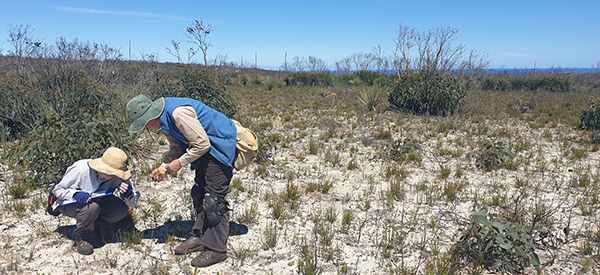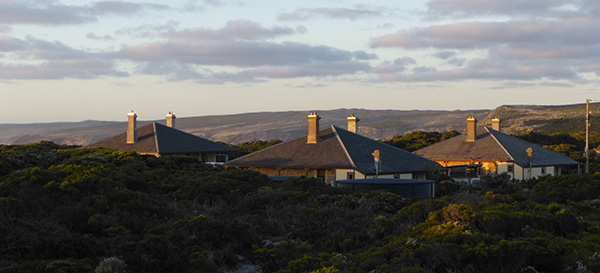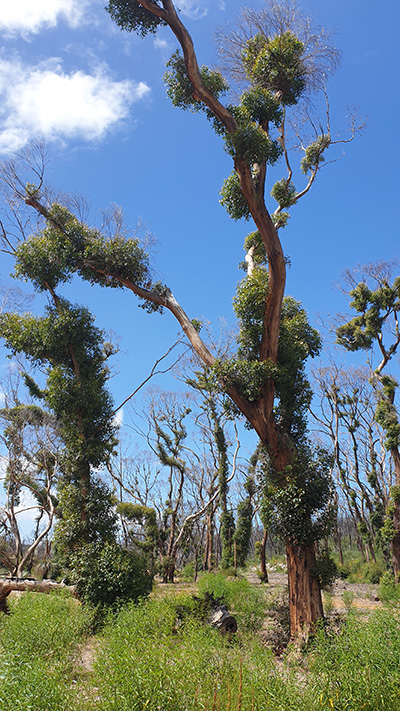The native plants from Kangaroo Island’s Flinders Chase continue to recover from the intense and devastating bushfires of 2019/2020. In the last week of February 2021, a team from the State Herbarium of South Australia – Helen Vonow, Tracey Spokes and Andrew Thornhill – went to Kangaroo Island to conduct a week-long botanical survey of the national park areas where bushfires had occurred. The purpose of the trip was to assess and collect plants that had grown back one year on. The team collected 350 plant specimens over the western, northern and central parts of Kangaroo Island at 13 different sites. They also visited another 12 sites and made observations of which species of plants were growing back. More than 60 species could be identified in the field; these species appear to be recovering as expected, given that the Australian flora is tough and has evolved and adapted to fire over a long time. Other species recovery will need to be observed over the coming months and years. This field work, along with upcoming trips in May, contribute to tracking the recovery of the KI wild vegetation and assist in supporting the recovery of rare and threatened species, with a number of other projects underway seeking to protect the unique and diverse flora of the island.

Tracey & Helen examining plant regrowth in the field. Photo: A. Thornhill.
Diary of a botanical field trip by State Herbarium of South Australia staff to the Kangaroo Island national park areas where the 2019/2020 bushfires occurred
Our field team’s mission was to visit as many sites in one week as possible across several different areas of burn severity, identify and collect as many plants as possible, and determine, if the plants that have returned have grown back from underground roots and stems (resprouting), or are re-growing from germinated seeds that survived the fires buried in the soil seed bank.
For those who have never been to Kangaroo Island, it is Australia’s third largest island and lies in the Southern Ocean about an hour and half drive from Adelaide in South Australia. Kangaroo Island (affectionately “KI”) has considerable native plant diversity as well as around 50 endemic plant species that are found nowhere else in the world.
We departed on the morning of the 25th of February 2021 and drove down to Cape Jervis to catch the ferry, loaded with supplies. The ferry trip to Kangaroo Island took us 40 minutes across the Backstairs Passage to Penneshaw. Once there, it took an hour and a half to drive the entire length of the island to the more remote western side. Our home for the week was Troubridge Cottage, one of the former lighthouse keeper’s houses at the Cape Du Couedic lighthouse. The cottage, along with its sister buildings, survived the fire although the area was burnt up to within about 100 metres of the buildings.

Our home for the week: The lighthouse keepers’ cottages and the unburnt area around them. Photo: T. Spokes.
Our first site was just off the Yacca Flat Track in an area of vegetation where the fire had reduced all the above-ground plant material to ash. What was immediately noticeable was how far we could see into the distance, which would have been obscured by vegetation prior to the fires, and that the topology of the land was largely exposed which made it easier to tell the type of soil the plants grow in. Typically, the underlying soil was pure sand with some rock scattered throughout. Similar observations were made at most other sites.
The team worked closely together to get as many plants surveyed as possible and everyone had a task at each site. Often Helen took the GPS waypoint and was chief plant identifier. Tracey kept track of recording all the data for each site and each plant, including taking notes from Helen’s observations. It is particularly important to keep track of the collection code that was assigned to each plant specimen, to enable all the observations, specimens and any future data, images or analyses to be connected to that collection. I (Andrew) ensured that the plants were photographed, acted as a roving plant spotter and also processed and pressed plant specimens. At each site we recorded details of the remaining vegetation, left standing from before the fire, the soil type, aspect of the site, and an estimation of how intense the fire was. For example, at some sites dead branches still had seed pods attached to them, while at others there was nothing left, only new growth was visible.

View of the area around Remarkable Rocks. Photo: A. Thornhill.
After making a summation of the site, it was plant collecting time. We started with the big plants and worked our way down to the smallest seedlings. Some of you may have tried to identify a plant, or at least asked your local friendly botanist to help with identifying a plant. To do this, you usually need to have flowers, fruit, some leaves and bark, if it is a tree. All of these characters help to identify a plant to species level. This is not the case in a recovering bushfire area, particularly in late summer. Some plants were in flower which made their identification easy, but the majority of plants required the detailed botanical knowledge of Helen, Tracey and Andrew to identify them – sometimes to species, but often, without any particular obvious characteristics, field IDs only made it to genus or in some cases family. There are over 1,000 species of flowering plant currently recorded on Kangaroo Island, scattered across different ecosystems and habitats (see also the Biological Survey of Kangaroo Island; 17mb PDF).
Here are some examples of characters we used:
- to identify the Eucalyptus species, we used leaf shape and colour, and burnt gumnuts as evidence of what the adult plant used to be
- for Hakeas, the team looked for remaining hard fruit on burnt stems
- the two Banksia species were separated using the type of hairs on the underside of the leaf.
Often leaf size and shape were used to determine plants to genus. Some plants were identified to family, based on their leaves only and will require further work, e.g. collecting flowers or fruits at a later time, which then might place them into another family. Some plants were left as ‘to be identified later’. In total, we collected close to 350 plant specimens over the western, northern and central parts of Kangaroo Island at 13 different sites. We also visited another 12 sites and made observations of what plants were growing back there.
An important observation and activity was to determine, whether the plant was growing back from an underground stem or as a new plant from a seed. This is a knowledge gap for many of our native plant species, which became evident as we evaluated expected vegetation recovery after the 2019/2020 fires. For each collection we scored whether the plant was a ‘re-sprouter’ or a seedling. This was done by excavating around the plant to see if old stems existed on the plant, or whether it was just root material likely to come from a germinated seedling. We observed at all sites that the eucalypts were growing back by resprouting from the base of burnt trunks – not as seedlings. There were some Eucalyptus seedlings around, but not many, we hope some of them will survive the tough conditions and re-establish. Hakea was also resprouting along with two other prickly genera of Proteaceae: Petrophile and Isopogon. Interestingly, the Banksia species were only found to be growing back from seedlings across all sites surveyed.
Why is it important to know if plants are resprouting or relying on seeds? Plant species that can regenerate from underground stems are considered most likely to come back in frequent fire affected areas. The plant species that only regenerate as seedlings will be more at risk if there is not adequate time to flower and set new seeds before another fire, and these plant species are more likely to be lost to an area. The information we are gathering will now help to identify the species on KI most at risk.

Regrowing bushland. Photo: T. Spokes.
As well as making herbarium specimens of the plants, the team spent each night taking leaves from every collection, placing them in tea bags and into boxes with silica gel to rapidly dry them. This method is used to store plant material for future DNA work.
As some of the plants that the team collected in the field were not identifiable based on physical characters, the DNA extracted from the plant material will enable molecular identification in the future, when it can be compared against our known DNA reference library. The State Herbarium of South Australia aims to generate a DNA reference library of every native South Australian plant species.
We expect that our next trip to extend these surveys, planned for May, will uncover a wider range of species recovering and we will continue to share these observations with the KI and SA community. Fingers crossed for some good rain and cooler weather in the meantime.

Tracey recording site information. Photo: A. Thornhill.
Written by Andrew Thornhill & Michelle Waycott.







